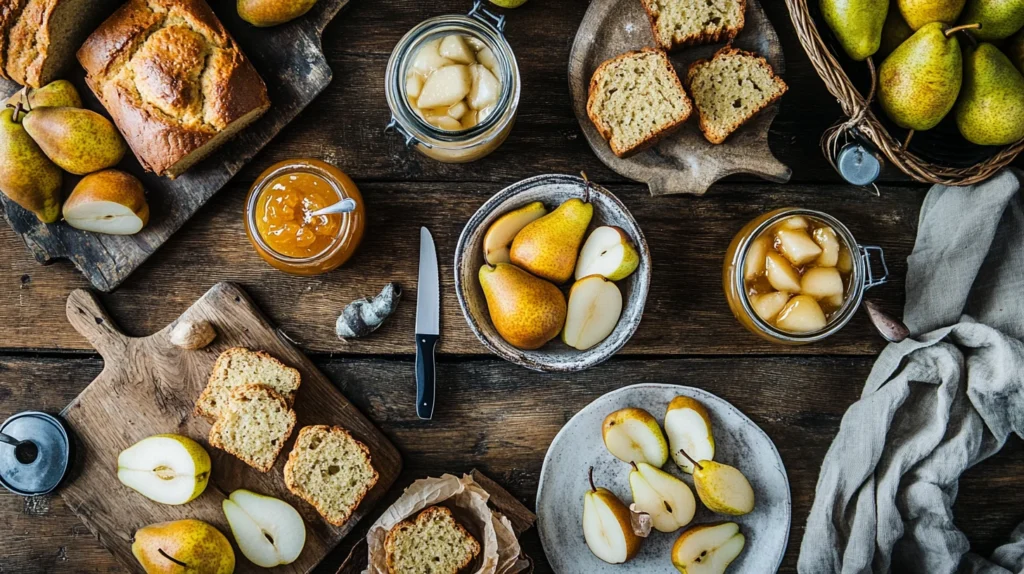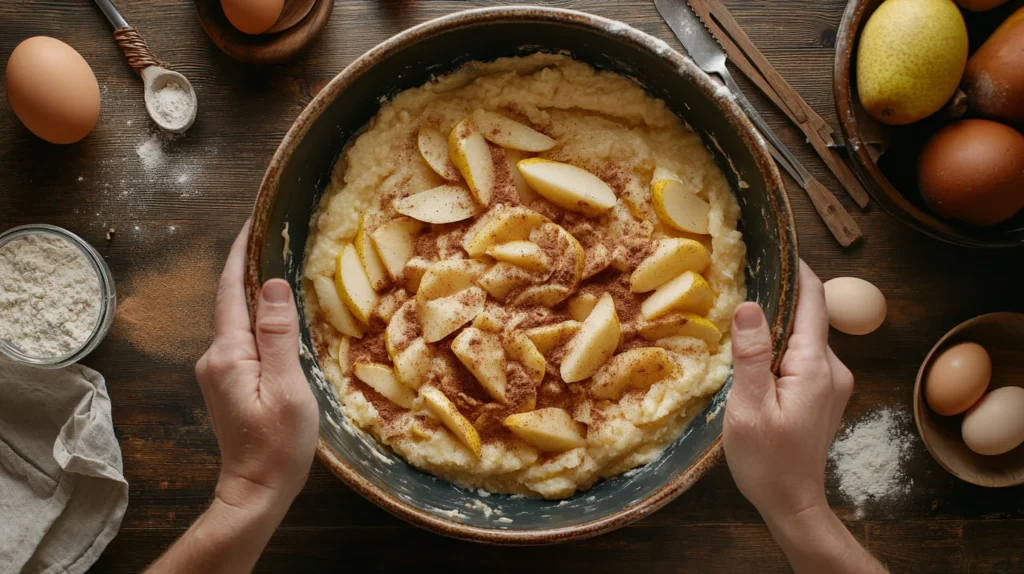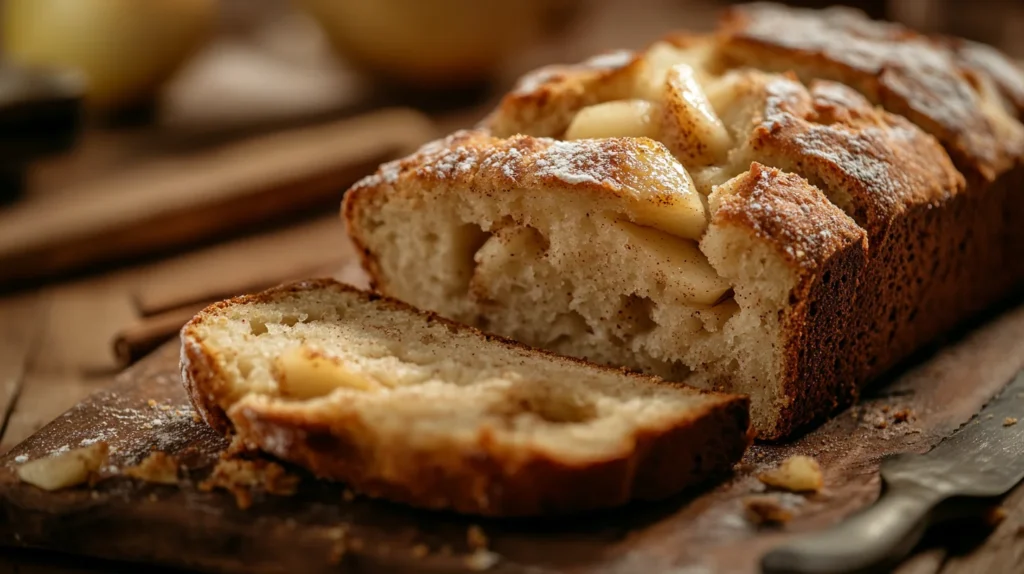There’s something magical about baking at home—the warm aromas drifting through the kitchen, the satisfaction of creating something from scratch, and, of course, the irresistible taste of a freshly baked loaf. If you’re wondering about the best way to use a lot of pears, this cozy and flavorful pear bread recipe is a perfect place to start. It turns ripe pears into a moist, spiced loaf that’s perfect for breakfast, snacks, or dessert.
Pear bread is a hidden gem in the world of homemade baked goods. While banana bread and zucchini bread have long stolen the spotlight, pear bread brings a fresh, tender, and juicy twist that’s simply unforgettable. Packed with the natural sweetness of ripe pears, warm spices like cinnamon and nutmeg, and a moist, cake-like crumb, it’s the perfect treat for any time of day.
Whether you’re a seasoned baker or just starting out, this guide will walk you through every step of the process—from selecting the perfect pears to serving up slices with style. You’ll learn not only how to bake pear bread to perfection but also how to experiment with gluten-free or vegan variations, how to store it properly, and how to make it kid-friendly and family-approved.
By the end of this article, you’ll have a go-to pear bread recipe that you’ll want to make over and over again. Let’s dive into this cozy and comforting bake that’s sure to win over your taste buds!
What is Pear Bread and Why It’s the Best Way to Use a Lot of Pears
History and Origins of Pear Bread
While pear bread might sound like a modern invention, fruit-based quick breads have been around for centuries. From humble beginnings as a way to use overripe or surplus fruits, these types of baked goods became a staple in kitchens across the globe. Banana bread and apple loaf were among the first to gain mainstream popularity in the U.S. during the Great Depression when people sought creative, budget-friendly ways to reduce waste.
Pear bread followed suit but remained a bit of a well-kept secret in Southern kitchens, particularly in areas where pear trees were plentiful. Traditionally baked in late summer and early fall—peak pear season—this bread combined the fruit’s juicy sweetness with warming spices to create a moist and flavorful treat that could be enjoyed fresh or stored for days.
Unlike its banana or pumpkin counterparts, pear bread never became overly commercialized. Instead, it remained a treasured homemade recipe passed down through generations, customized with nuts, raisins, or a hint of ginger depending on the family tradition.
What Makes Pear Bread Unique
So, what sets pear bread apart from other fruit breads?
First and foremost, it’s the moisture content. Pears, especially when ripe, are loaded with natural juices. This keeps the bread incredibly moist without the need for excessive butter or oil, making it a slightly lighter option while still rich in flavor. The grainy texture of pears breaks down during baking, blending seamlessly into the batter to give the loaf a tender crumb and a hint of fruity goodness in every bite.
Another unique aspect is the subtle sweetness. Pears lend a gentle, natural sugar profile that balances well with warming spices like cinnamon, nutmeg, and clove. The result is a loaf that isn’t cloyingly sweet but perfectly comforting, ideal for breakfast, a coffee break, or dessert.
And let’s not forget the versatility of pear bread. You can dress it up with a powdered sugar glaze, keep it rustic with a walnut or pecan topping, or go health-conscious with whole wheat flour and coconut sugar. It’s also one of those recipes that’s easily adaptable for gluten-free, dairy-free, or vegan lifestyles.
Pear Bread vs. Banana Bread
While banana bread remains a classic, pear bread offers a refreshing change. Banana bread often has a denser texture and a stronger flavor, whereas pear bread is lighter, more aromatic, and has a tender, almost melt-in-your-mouth consistency. If you’re looking to switch things up but want to stay within the realm of cozy, nostalgic baking, pear bread is an excellent choice.
Seasonal Appeal
Pear bread shines in the fall and winter months, when pears are in peak season and comfort food is on everyone’s mind. It pairs beautifully with spiced teas, warm apple cider, or even a dollop of whipped cream for a holiday dessert. However, thanks to the year-round availability of pears in grocery stores, you can make this recipe anytime the craving strikes.
Choosing the Best Pears for Baking and Using Up a Lot of Pears

Best Pear Varieties for Baking Pear Bread
Not all pears are created equal—especially when it comes to baking. The variety of pear you choose can significantly affect the texture, flavor, and moisture of your bread. Below are some of the best pear varieties for baking:
Bartlett Pears
The most commonly used pear for baking, Bartlett pears are juicy, sweet, and aromatic. They soften easily, making them ideal for recipes where the fruit blends into the batter. When fully ripe, their flesh turns buttery and tender, which contributes to the moist crumb in pear bread.
Bosc Pears
Bosc pears have a firmer texture and a slightly more intense sweetness. Because they hold their shape well during baking, they’re great if you want small chunks of pear visible in your bread. Their spicy flavor also complements warm spices like cinnamon and clove beautifully.
Anjou Pears
Anjou pears (green or red) are less juicy than Bartletts but still sweet and pleasant. They work well when you want a more subtle pear flavor or when mixing pears with other fruits like apples. Their flesh doesn’t break down as quickly, giving the bread a slightly firmer bite.
Asian Pears – Use with Caution
Asian pears are super crisp and juicy but not ideal for traditional pear bread. Their high water content can make the batter too wet unless properly drained or pre-cooked. If you use them, reduce the liquid in your recipe slightly.
How to Tell If Pears Are Ripe
Unlike apples, pears ripen off the tree. So even if the pears you pick up at the store are firm, don’t worry—they’ll ripen over a few days at home.
Here’s how to tell if your pears are ready for baking:
- Check the neck: Gently press near the stem. If it gives slightly, the pear is ripe.
- Look for aroma: A sweet, floral scent is a good sign of ripeness.
- Skin color: Depending on the variety, ripe pears will change from green to yellow (Bartlett) or develop a golden hue (Bosc).
How to Ripen Pears Quickly
Need ripe pears in a hurry? Use these kitchen hacks:
- Brown paper bag method: Place pears in a paper bag with a ripe banana or apple. The ethylene gas speeds up the ripening process.
- Room temperature trick: Simply leave pears out on the counter away from direct sunlight. They usually ripen within 2–3 days.
Avoid refrigerating unripe pears—it slows down the ripening process. Once fully ripe, you can refrigerate them to delay over-ripening for up to 2–3 days.
Prepping Pears for Baking
Once your pears are ripe, here’s how to prep them:
- Peel the skin – While the skin is edible, it can create unwanted texture in baked goods.
- Core and dice – Remove the seeds and dice the pear into small cubes for even distribution.
- Drain excess juice – If your pears are very juicy, pat them with a paper towel to avoid overly wet batter.
Pro Tip – Mix Pear Varieties
Want depth of flavor? Try using two different types of pears in the same recipe. Combine the softness of Bartlett with the firmness of Bosc for a delightful mix of textures in each bite.
Key Ingredients for Pear Bread: A Delicious Way to Use Extra Pears
Dry Ingredients Breakdown
All-Purpose Flour
The foundation of the bread, all-purpose flour gives structure to the loaf. It creates a soft crumb that pairs beautifully with the moisture of the pears. For a denser or more wholesome option, you can substitute with half whole wheat flour—just expect a slightly nuttier flavor and heartier texture.
Baking Soda and Baking Powder
These leavening agents are essential for helping the bread rise. Baking soda reacts with the acidity in the pears and other ingredients to create lift, while baking powder offers additional rise and fluffiness.
Spices
Spices elevate pear bread from basic to bakery-level. Here are the essentials:
- Ground cinnamon – Adds warmth and depth
- Nutmeg – A hint of sweetness with a slightly nutty note
- Ginger or cloves (optional) – For those who love bolder spice flavors
Salt
A pinch of salt sharpens the other flavors and balances the sweetness. Don’t skip it!
Wet Ingredients Explained
Ripe Pears (Freshly Grated or Diced)
This is the heart of the recipe. Grated pears melt into the batter, adding intense moisture and natural sweetness, while diced pears create soft fruit pockets throughout the loaf. You can use either method or a mix of both for texture contrast.
Eggs
Eggs help bind everything together and contribute to the richness and tenderness of the bread. Use room temperature eggs for better mixing and fluffier results.
Oil or Butter
Fat gives the bread a moist crumb and prevents it from drying out. Many recipes use vegetable oil or canola oil for a neutral flavor, but you can also use melted butter for a richer taste.
Sugar
Granulated sugar adds sweetness, while brown sugar adds a touch of molasses flavor and extra moisture. A combination of both works beautifully in pear bread.
Vanilla Extract
Just a teaspoon of pure vanilla extract enhances the flavor of the pears and spices, making the whole loaf more aromatic and indulgent.
Yogurt, Sour Cream, or Buttermilk (Optional)
Adding a scoop of yogurt, sour cream, or buttermilk makes the bread even more tender and moist. It also adds a slight tang that balances the sweetness of the pears.
Optional Add-ins
Nuts
Chopped walnuts or pecans add crunch and earthiness that contrast beautifully with the soft bread. Toast them first for an even deeper flavor.
Raisins or Dried Cranberries
For an added burst of sweetness and texture, toss in a handful of dried fruit. Make sure to soak them in warm water for 10 minutes to plump them up before mixing into the batter.
Chocolate Chips
Not traditional, but delicious! Semi-sweet or dark chocolate chips give your pear bread a dessert-like twist, perfect for kids or indulgent cravings.
Shredded Coconut or Carrots
If you want to turn your pear bread into a fruit-and-veggie loaf, try adding a small amount of finely shredded carrot or unsweetened coconut. These bring in extra moisture and nutrition.
Ingredient Substitution Table
| Ingredient | Substitution | Notes |
|---|---|---|
| All-purpose flour | 1:1 Gluten-Free Baking Flour | For a gluten-free version |
| Vegetable oil | Melted butter, coconut oil, or applesauce | Adjust liquid content if using applesauce |
| Eggs | Flax eggs or chia eggs | For a vegan-friendly loaf (1 egg = 1 tbsp flax + 3 tbsp water) |
| Sugar | Coconut sugar, maple syrup, or honey | May affect sweetness level and moisture |
| Dairy yogurt | Plant-based yogurt or applesauce | Keeps the loaf dairy-free and moist |
Step-by-Step Pear Bread Recipe

Preparation Process
1 – Gather Your Ingredients
Before you start baking, make sure you have all your ingredients measured, prepped, and ready to go. This includes peeling, coring, and dicing or grating your ripe pears. If you’re using optional add-ins like nuts or raisins, prep those too.
2 – Preheat Your Oven
Set your oven to 350°F (175°C). This is the ideal temperature for baking fruit-based quick breads, ensuring a golden-brown crust and fully baked center.
3 – Grease the Pan
Use a 9×5-inch loaf pan and grease it well with nonstick spray or butter.
4 – Mix the Dry Ingredients
In a large bowl, whisk together:
- 2 cups all-purpose flour
- 1 teaspoon baking soda
- 1/2 teaspoon baking powder
- 1/2 teaspoon salt
- 1 teaspoon cinnamon
- 1/4 teaspoon nutmeg
- Optional: 1/8 teaspoon cloves or ground ginger
Mix thoroughly to distribute the leavening agents and spices evenly.
5 – Combine the Wet Ingredients
In a separate bowl, whisk together:
- 2 large eggs (room temperature)
- 1/2 cup vegetable oil or melted butter
- 3/4 cup granulated sugar (or a mix of white and brown)
- 1 teaspoon vanilla extract
- Optional: 1/4 cup yogurt or sour cream for extra moisture
Then gently fold in 1 1/2 to 2 cups of grated or finely diced ripe pears. The pears should be juicy but not overly wet. Pat them dry if needed.
6 – Combine Wet and Dry Mixtures
Pour the wet mixture into the bowl of dry ingredients. Use a spatula or wooden spoon to stir just until combined. Avoid overmixing, which can make the bread tough.
If using optional add-ins like 1/2 cup chopped nuts or soaked raisins, fold them in at this stage.
Baking Instructions
7 – Pour Into Loaf Pan
Transfer the batter into the prepared loaf pan. Use the back of a spoon or spatula to smooth the top evenly. If desired, sprinkle a few chopped nuts or a pinch of brown sugar on top for a crunchy crust.
8 – Bake to Perfection
Bake at 350°F (175°C) for 50–60 minutes, or until a toothpick inserted into the center comes out clean. Ovens vary, so check around the 50-minute mark, especially if your pears were extra juicy.
If the top browns too quickly, loosely tent it with aluminum foil for the last 10–15 minutes of baking.
Cooling and Serving Tips
9 – Cool in Pan
Allow the bread to cool in the pan for about 10–15 minutes. This helps it firm up and makes it easier to remove without falling apart.
10 – Transfer to Wire Rack
Carefully lift the loaf out of the pan and place it on a wire rack to cool completely. This prevents sogginess from steam.
11 – Slice and Enjoy
Once cooled, slice the pear bread using a serrated knife for clean, even slices. Enjoy warm with a pat of butter, a drizzle of honey, or just as it is—moist, fragrant, and full of homemade goodness.
Tips for Perfectly Moist Pear Bread

Ingredient Ratios Matter
Moisture is key! Use at least 1½ to 2 cups of ripe pears, either grated or finely chopped. Adding too little pear can lead to a dry loaf, while too much may make it soggy or undercooked. Balance is everything.
Don’t Overmix the Batter
Quick breads like pear bread can turn dense if overmixed. Once you combine the wet and dry ingredients, stir just until no flour streaks remain. A few small lumps are fine.
Watch Your Bake Time
Pears add a lot of moisture, which may extend the baking time. Always check for doneness using a toothpick—if it comes out clean or with a few moist crumbs, it’s ready.
Creative Variations: More Ways to Use a Lot of Ripe Pears in Baking
Gluten-Free Pear Bread
Use a 1:1 gluten-free flour blend with xanthan gum for best results. Almond flour or oat flour can also work but may require adjustments in liquid and baking time.
Vegan Pear Bread
Swap out the eggs for flax eggs (1 tbsp flaxseed meal + 3 tbsp water per egg), and use plant-based yogurt or applesauce instead of dairy. Opt for vegetable or coconut oil in place of butter.
Sugar-Free or Low-Sugar Options
You can replace sugar with monk fruit sweetener, stevia blend, or maple syrup (reduce other liquids slightly). Keep in mind that sugar also affects texture and browning.
Add Warm Autumn Flavors
Try adding a pinch of cardamom, allspice, or pumpkin pie spice for a seasonal spin. A splash of pear liqueur or bourbon can also enhance flavor for adult versions.
How to Store Pear Bread When You’ve Used a Lot of Fresh Pears
Room Temperature Storage
Once cooled, wrap the loaf tightly in plastic wrap or place it in an airtight container. It stays fresh at room temperature for 2–3 days.
Refrigeration
If your kitchen is warm or humid, refrigerate the bread to extend its life. It can last up to 5–6 days when properly stored in the fridge.
Freezing Instructions
Pear bread freezes beautifully!
- Wrap: Double-wrap slices or the full loaf in plastic wrap, then foil.
- Store: Place in a freezer-safe bag or container.
- Shelf Life: Up to 3 months in the freezer.
- To Reheat: Thaw overnight at room temperature or microwave slices for 30–45 seconds.
Pairing Ideas and Serving Suggestions
- Breakfast: Toasted with butter and cinnamon sugar
- Dessert: Served warm with whipped cream or vanilla ice cream
- Snacks: Paired with tea, coffee, or chai lattes
- Brunch Platter: Sliced pear bread with fruits, cheeses, and jams
Common Mistakes to Avoid
- Using underripe pears: Not sweet or soft enough for baking
- Overmixing the batter: Leads to a dense or tough loaf
- Skipping spices: Leaves the bread tasting flat
- Wrong pan size: A loaf pan that’s too small can cause overflow or underbaking
Love Pear Bread? Try These Fruity Favorites Too:
- Craving something similar? Check out this moist banana bread recipe for another sweet twist on classic loaves.
- Want a zesty bite? These fruity muffin flavors combine citrus and berries for a vibrant morning treat.
- If tropical flavors are your thing, this moist fruit-based dessert is another must-try.
Frequently Asked Questions (FAQs)
What is the best way to use a lot of pears?
If you have a big batch of ripe pears, here are some of the best ways to use them up:
- Bake Pear Bread or Muffins – A perfect way to use 2–3 pears per loaf.
- Make Pear Sauce – Like applesauce, pear sauce can be spiced and stored or frozen.
- Can or Preserve Pears – Create pear jam, chutney, or canned pear halves in syrup.
- Poached Pears – Elegant and easy, poached pears in wine or spiced syrup make a great dessert.
- Add to Salads or Smoothies – Fresh pears are great tossed into green salads or blended into creamy smoothies.
- Pear Crumble or Pie – Use several pears in a fruit crumble, crisp, or rustic galette.
- Freeze for Later – Peel, core, and freeze pears in slices to use later in baking or cooking.
Do I have to peel pears for baking?
Not always, but usually yes. Here’s why:
- Peeled pears blend into the batter more smoothly and give baked goods a uniform texture.
- Unpeeled pears work if you want added texture or rustic appearance (especially in crisps or galettes), but the skin may be slightly tough after baking.
For pear bread or cake, it’s best to peel the pears to ensure the bread is soft and tender throughout.
What can I make with lots of pears?
Here’s a list of delicious recipes to help you make the most of your pear stash:
- Pear Bread or Muffins
- Pear and Ginger Crumble
- Pear Jam or Butter
- Roasted Pears with Honey and Cinnamon
- Pear Upside-Down Cake
- Pear Tart or Galette
- Pear and Brie Puff Pastry Bites
- Pear Smoothies
- Savory Dishes – Add sliced pears to pork dishes, grilled cheese sandwiches, or risottos
You can also dehydrate pears to make pear chips—a healthy, long-lasting snack.
Can you put pear in banana bread?
Absolutely! Pear and banana go surprisingly well together.
- You can replace part of the banana with grated or mashed pear to add moisture and a fruity flavor twist.
- Use about 1 cup of ripe grated pear along with 1–2 mashed bananas.
- Pear adds a gentle sweetness and soft texture, making the loaf extra moist.
Just remember to adjust the sugar slightly if your bananas and pears are both very ripe and sweet.
Conclusion
Pear bread might not be the most talked-about baked good, but it definitely deserves a spot in your kitchen. With its naturally sweet flavor, moist crumb, and cozy spice profile, it’s a comforting and surprisingly versatile recipe. Whether you keep it simple or jazz it up with nuts, spices, or even chocolate chips, this loaf is a delicious way to enjoy ripe pears and share a slice of homemade love. So grab those ripe pears, preheat your oven, and get ready to fill your home with the irresistible aroma of fresh-baked pear bread. Happy baking!

Moist and Spiced Pear Bread Recipe
Equipment
- 9×5-inch loaf pan
- Large mixing bowl
- Medium mixing bowl
- Whisk and spatula
- Box grater (if grating pears)
- Measuring cups and spoons
- Cooling rack
- Parchment paper (optional)
Ingredients
- Dry Ingredients:
- 2 cups 240g all-purpose flour
- 1 teaspoon baking soda
- ½ teaspoon baking powder
- ½ teaspoon salt
- 1 teaspoon ground cinnamon
- ¼ teaspoon ground nutmeg
- Optional: ⅛ teaspoon ground cloves or ginger
- Wet Ingredients:
- 2 large eggs room temperature
- ¾ cup 150g granulated sugar (or half white, half brown sugar)
- ½ cup 120ml vegetable oil or melted butter
- 1 teaspoon vanilla extract
- ¼ cup 60g yogurt, sour cream, or buttermilk (optional for extra moisture)
- 1½ to 2 cups about 2–3 medium grated or finely diced ripe pears, peeled
- Optional Add-ins:
- ½ cup chopped walnuts or pecans
- ⅓ cup raisins or dried cranberries
- ¼ cup mini chocolate chips
Instructions
- Preheat the oven to 350°F (175°C). Grease a 9×5-inch loaf pan or line with parchment paper.
- In a large bowl, whisk together flour, baking soda, baking powder, salt, cinnamon, nutmeg, and optional spices.
- In a separate bowl, beat the eggs, then add sugar, oil (or melted butter), vanilla, and yogurt (if using). Mix well.
- Fold in the grated or chopped pears until well distributed.
- Combine the wet and dry ingredients, mixing gently until just combined. Do not overmix.
- Add any optional mix-ins like nuts or raisins and stir gently.
- Pour the batter into the loaf pan and smooth the top.
- Bake for 50–60 minutes, or until a toothpick inserted into the center comes out clean.
- Let cool in the pan for 10–15 minutes, then transfer to a wire rack to cool completely.
- Slice and serve plain, or with a spread of butter, honey, or cream cheese.
Notes
For extra moisture, use grated pear; for texture, use finely chopped.
Bread can be stored at room temperature for 2–3 days, refrigerated for 5–6 days, or frozen for up to 3 months.
Optional: Sprinkle a little brown sugar or chopped nuts on top before baking for a crunchy finish.

